
If you love to cook brats as much as you like to eat them, you probably possess a quality that the brats lack: a thick skin. This quality comes in handy when the invariable kidding begins around the dinner table about why it's so difficult to cook a brat that doesn’t "keep its stuff together." Bratwurst casings are notoriously thin, and under the pulsating surge of building heat, they can explode into a mass of "bratwurst stew." Although you may want to pass the barbecue tongs to a willing volunteer, hang tough. Take a few preventative steps, practice, and soon you’ll be cooking brats with no splits.
Step 1
Purchase a pair of tongs that feel comfortable in your hand and that you will use -- religiously -- as you grill your brats. Using a fork is a no-no because it can pierce a hole in brats, causing them to split open, releasing the juices and maybe even causing a scary flame flare-up. Avoid problems by using a pair of tongs that have smooth ends that will treat your brats as gingerly as you will.
Step 2
Poach the bratwurst in a water or beer bath over a low flame on your grill. Add some chopped onions or sauerkraut, and let the flavors and juices commingle, stirring occasionally. Place the entire mixture in an aluminum pan on your grill. Give the brats about 20 or 25 minutes to heat slowly, which will greatly reduce the likelihood of the brat casing bursting open. The interior temperature of the brats should reach 150 degrees Fahrenheit -- a finished temperature that means you only have to brown the brats nicely on the outside.
Step 3
Brush your brats with a light layer of olive oil to baby them -- and their delicate casing -- a little more as you place them on the grill. Set the flame to low-medium.
Step 4
Grill the brats for about 5 minutes on each side, rolling them from the cool to the warmer sections of your grill. Err on the side of using a lower flame; you’ve come this far without splitting the casing, and a too-high flame can undercut your best efforts.
Related Articles

How to Cook Stadium Style Brats
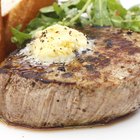
How to Grill Pork Tenderloins on a ...
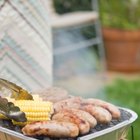
How to Cook Fresh Chicken Bratwurst
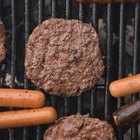
How to Cook a Frozen Beef Patty ...

How to Blanch Sausage
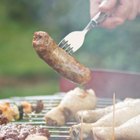
How to Soak Brats in Beer

How to Cook a Frozen Burger in a Skillet
How to Barbecue Prime Rib Bones
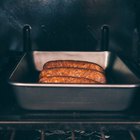
How to Cook Turkey Bratwurst in the Oven

How to Marinate Bratwurst

How to Cook Chicken Bratwurst

How to Cook Haddock on the Grill
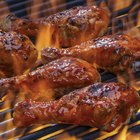
How to Cook Chicken in a Crockpot & ...

How to Cook Venison Medallions

How to Cook Filet Mignon Medallions on ...

How to Cook Cheddar Brats

How to Cook a Pork Chop on a Dome ...

How to Cook Brats on the Griddle
Ideas for a Menu With Bratwurst

How to Grill Boneless Chicken Strips
References
Resources
Tips
- Technically, you should bring ground meat to an internal temperature of 160 degrees F. But this temperature -- and even 155 degrees F -- can produce a brat that is overcooked, dry and shriveled. Experiment until you find the perfect result.
- Sprinkle a little sugar on the bratwurst before placing it on the grill, if desired. The sugar will caramelize and encrust the brats with a richer, browner color.
Writer Bio
Mary Wroblewski earned a master'sdegree with high honors in communications and has worked as areporter and editor in two Chicago newsrooms. She launched her ownsmall business, which specialized in assisting small business ownerswith “all things marketing” – from drafting a marketing planand writing website copy to crafting media plans and developing emailcampaigns. Mary writes extensively about small business issues, andespecially “all things marketing.”
Photo Credits
Jupiterimages/liquidlibrary/Getty Images